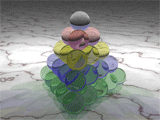
A truncated triangular pyramid number is found by removing (truncating) some smaller tetrahedral number (or triangular pyramidal number) from each of the vertices of a bigger tetrahedral number.
The number to be removed (truncated) may be same or different from each of the vertices.

Properties
A truncated number is not the same as the volume or area of the truncated shape.
Instead numbers relate more to the problem of how densely given solid objects can pack in space. Dense packing of convex objects is related to problems like the arrangement of molecules in condensed states of matter and to the best way to transmit encoded messages over a noisy channel. Kepler's conjecture, which postulated that the densest packings of congruent spheres in 3-dimensional space have packing density (fraction of space covered by the spheres) = pi / sqrt 18 = 74.048% was proved by variants of the face-centered cubic (FCC) lattice packing.
It is hypothesised that a regular tetrahedron might possibly be the convex body having the smallest possible packing density. In contrast to this, the densest known packing of truncated tetrahedra can have an exceptionally high packing fraction φ = 207/208 = 0.995192...
Truncated numbers are also relevant to cluster science in inorganic chemistry. Central to the chemical and physical study of clusters is a understanding of their molecular and electronic structures which is determined by the number of atoms in a cluster of given size and shape and their arrangement or disposition. Semiconductors are one of the most active areas of cluster research.
Examples
Tetrahedral Number 20 (sequence A000292 in the OEIS) yields Truncated Triangular Pyramid Number 7 (sequence A051937 in the OEIS) by truncating Tetrahedral number (or triangular pyramidal number) 4,4,4 and 1 from its vertices
Tetrahedral Number 35 (sequence A000292 in the OEIS) yields Truncated Triangular Pyramid Number 19 (sequence A051937 in the OEIS) by truncating Tetrahedral number (or triangular pyramidal number) 4 from each of the vertices
Tetrahedral Number 286 (sequence A000292 in the OEIS) yields Truncated Triangular Pyramid Number 273 (sequence A051937 in the OEIS) by truncating Tetrahedral number (or triangular pyramidal number) 4,4,4 and 1 from its vertices
Tetrahedral Number 560 (sequence A000292 in the OEIS) also yields Truncated Triangular Pyramid Number 273 (sequence A051937 in the OEIS) by truncating Tetrahedral number (or triangular pyramidal number) 84,84,84 and 35 from its vertices
Tetrahedral Number 816 (sequence A000292 in the OEIS) yields Truncated Triangular Pyramid Number 689 (sequence A051937 in the OEIS) by truncating Tetrahedral number (or triangular pyramidal number) 56,35,35 and 1 from its vertices
Tetrahedral Number 969 (sequence A000292 in the OEIS) yields Truncated Triangular Pyramid Number 833 (sequence A051937 in the OEIS) by truncating Tetrahedral number (or triangular pyramidal number) 56,35,35 and 10 from its vertices
Related numbers
Certain truncated triangular pyramid numbers possess other characteristics:
273 (number) is also a sphenic number and an idoneal number
204 (number) is also a square pyramidal number and a nonagonal number
In other fields
- Truncated triangular silver nanoplates synthesized in large quantities using a solution phase method
- Theoretical study of hydrogen storage in a truncated triangular pyramid molecule
- Packing and self-assembly of truncated triangular bipyramids
References
- Sloane, N. J. A. (ed.). "Sequence A051937 (Truncated triangular pyramid numbers))". The On-Line Encyclopedia of Integer Sequences. OEIS Foundation.
- Weisstein, Eric W. "Truncated Tetrahedral Number". mathworld.wolfram.com. Retrieved 2024-10-23.
- ^ Conway, J. H.; Torquato, S. (2006). "Packing, tiling, and covering with tetrahedra". Proceedings of the National Academy of Sciences. 103 (28): 10612–10617. Bibcode:2006PNAS..10310612C. doi:10.1073/pnas.0601389103. PMC 1502280. PMID 16818891.
- "Torquato, S. (2002) Random Heterogeneous Materials: Microstructure and Macroscopic Properties (Springer, New York)". doi:10.1115/1.1483342.
- Conway, J. H.; Sloane, N. J. A. (9 March 2013). Conway, J. H. & Sloane, N. J. A. (1998) Sphere Packings, Lattices and Groups (Springer, New York). Springer. ISBN 978-1-4757-2249-9.
- "Hales, T. C. (2005) Ann. Math. 162, 1065–1185". JSTOR 20159940.
- https://pubs.aip.org/aip/jcp/article/135/15/151101/190281/Communication-A-packing-of-truncated-tetrahedra
- Teo, Boon K.; Sloane, N. J. A. (1985). "Magic numbers in polygonal and polyhedral clusters". Inorganic Chemistry. 24 (26): 4545–4558. doi:10.1021/ic00220a025.
- Brauman, John I. (1996). "Clusters". Science. 271 (5251): 889. Bibcode:1996Sci...271..889B. doi:10.1126/science.271.5251.889.
- Califano, Marco (2024-02-13). "Tetrahedral vs Spherical Nanocrystals: Does the Shape Really Matter?". Chemistry of Materials. 36 (3): 1162–1171. doi:10.1021/acs.chemmater.3c01643. ISSN 0897-4756.
- Chen, Sihai; Carroll, David L. (2002). "Synthesis and Characterization of Truncated Triangular Silver Nanoplates". Nano Letters. 2 (9): 1003–1007. Bibcode:2002NanoL...2.1003C. doi:10.1021/nl025674h.
- Ishikawa, Shigeru; Nemoto, Tetsushi; Yamabe, Tokio (2018). "Theoretical study of hydrogen storage in a truncated triangular pyramid molecule consisting of pyridine and benzene rings bridged by vinylene groups". Applied Physics A. 124 (6): 418. Bibcode:2018ApPhA.124..418I. doi:10.1007/s00339-018-1841-9.
- Haji-Akbari, Amir; Chen, Elizabeth R.; Engel, Michael; Glotzer, Sharon C. (2013). "Packing and self-assembly of truncated triangular bipyramids". Physical Review E. 88 (1): 012127. arXiv:1304.3147. Bibcode:2013PhRvE..88a2127H. doi:10.1103/PhysRevE.88.012127. PMID 23944434.